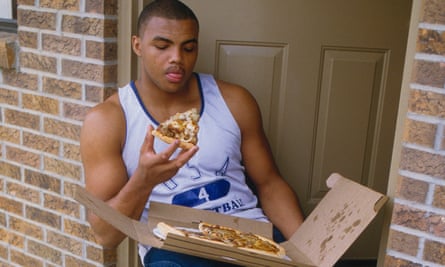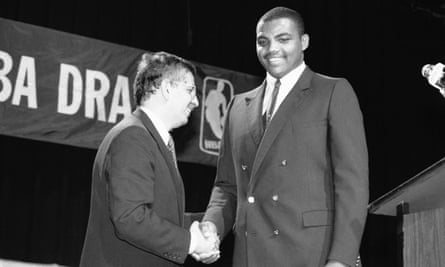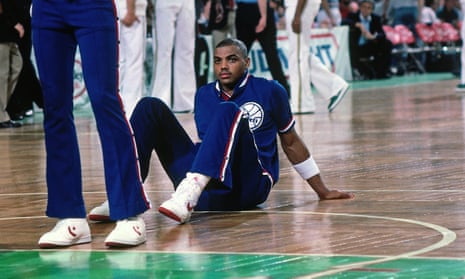For a 48-hour period in 1984, Charles engaged in an eating binge in hopes of dissuading the Philadelphia 76ers from selecting him in the draft. He began with two Denny’s Grand Slam breakfasts – six pancakes and bacon totaling around 1,660 calories, and a vanilla milkshake to wash it down. The lunch offerings, which have varied in the decades’ worth of repeat tellings, included either Kentucky Fried Chicken, mashed potatoes, and coleslaw; half of the menu at Red Lobster; two McDonald’s fish fillets, a large fries, and a Diet Coke; or two Texas-sized barbecue sandwiches. The dinner menu at a steakhouse included a T-bone, baked potato, and, of course, three desserts.
Charles repeated it all the next day, gorging, as he described, “everything I could get to my face, everything that wasn’t nailed down or poison.” During a night of heavy drinking with his agent, the sight of Charles crushing beers might have made people think that Prohibition was about to be reinstated, he said.
This excess consumption was never the plan, but the league’s unstable footing complicated Charles’s financial future.
The NBA was struggling. On top of the rampant cocaine abuse among players, TV executives and advertisers felt the league was not marketable to mainstream America because it was too Black. Critics supported the notion that by pointing to Marvin Gaye’s rendition of The Star-Spangled Banner at the 1983 All-Star Game, a groundbreaking, funky version of the national anthem meant to reflect the Black excellence of the players on the court. All of this came as salaries had spiked too quickly and several franchises were in danger of folding.
To address the escalating problems plaguing the league, the collective bargaining agreement announced for the 1984–85 season helped institute a salary cap. Teams with payrolls at or above the salary cap could only offer their first-round picks a one-year deal worth $75,000. In other words, whoever was getting picked by Philadelphia, a franchise capped out at around $4.5m, would not have the security of a multiyear, multimillion-dollar deal.
Charles had already lost about 10lbs that summer, a request made by the 76ers before a pre-draft weigh-in. Then, Charles’s agent, Lance Luchnick, had some tough news to deliver to his prized client.
“You do know if the Sixers draft you they are going to give you $75,000, right?” Luchnick said to Charles.
“I didn’t leave college for $75,000,” Charles replied to his new agent in a not-so-calm tone.
By Charles’s standards, the caloric clinic worked: he gained roughly 20lbs in two days, putting him at nearly 300lbs.
At a weigh-in, Harold Katz, the 76ers’ owner who made his fortune as founder of Nutrisystem, the national chain of weight-loss centers, flew off the handle as Charles tried not to laugh. Are you nuts or just fat and lazy? Pat Williams, the team’s loquacious general manager, was rendered speechless and alarmed by “this enormous girth.”
On the Amtrak train to New York for the draft, Charles and Luchnick high-fived each other on a job well done. There was no way the 76ers would take Charles Barkley now. No way.
That’s what they thought anyway.

Charles was certainly not a secret to the Sixers. Months earlier, Jack McMahon, the team’s director of player personnel, described the Auburn star to Sports Illustrated as having the body of Wes Unseld and the ups of Julius Erving, while also noting that any team that took him on would “have to put a weight clause in his contract.” But the owner, Katz, spoke of Charles glowingly.
“Harold was in awe of Charles Barkley,” said John Nash, then the team’s assistant general manager.
The entrepreneur bought the 76ers from F Eugene Dixon for more than $12m in 1981, inheriting a pricy payroll, low attendance, and significant financial losses. Katz, a ball of fire who acknowledged it was “bananas” to take on a franchise in peril, vowed to turn it around. To him, the only thing worse than losing money, no matter how much of it you have, was getting beat on the basketball court. In 1983, less than two years later, the Sixers won their first NBA championship in 16 years behind Erving and league MVP Moses Malone, sweeping the Los Angeles Lakers and bringing pride back to the hoops haven.
Ed Rendell, who at 33 had become the youngest district attorney in the city’s history, remembered Katz as a respected but aloof figure with a reputation and edge that earned him admiration throughout Philadelphia.
“Harold was a guy who got things done. I don’t think the fans loved Harold, but they respected what he did with the title in ’83,” said Rendell, a Democrat who later served as mayor. “If you asked the average 76ers fan about Harold Katz, they’d say he did some good, but that he was a real SOB, because he was very tough.”
And now, Katz was all-in on Charles. But Billy Cunningham had some hesitation. The head coach worked out the prospect at Saint Joseph’s University in Philadelphia six weeks before the draft. Within five minutes of Charles jumping from a standing position to effortlessly grab rebound after rebound, Cunningham too was all-in.
“The one great gift Charles had was that it was an easy game for him,” said the Hall of Fame player–turned-coach. “It wasn’t complicated.”
Scouting reports from draft experts echoed what the Sixers saw. “If he ever gets down to 250, fasten the seatbelts and clear the runway,” Sports Illustrated declared.
The weight still presented a hang-up for the organization ahead of the June event, so Katz and Williams challenged the 282lbs Charles to lose about 10lbs. Working out in Leeds, Alabama, and Houston, Charles jogged and lifted weights to get to around 272. “Mostly, I just stopped eating,” Charles joked. Then, Charles went the other way, employing a man-versus-food approach never before seen by an elite athlete trying to convince a team to avoid drafting him – both the tastiest and most painful to date.
For reasons that remain unclear, burgundy was Barkley’s favorite color growing up. He was all smiles in a burgundy tuxedo when he took Amy Shorter to the prom his senior year. The burgundy tracksuit he rocked in the pizza-centric photoshoot for Sports Illustrated never looked better on someone with a mouthful of a supreme slice.
On the day of the NBA Draft, he wore a double-breasted burgundy suit with gold buttons
“When you’re poor, you get that one suit and that was it,” he said. “Man, burgundy was my favorite color. I wanted to have a nice suit for the Draft, and we went out and got it.”
The outfit was just one element of what’s considered by many the greatest NBA Draft in the history of the game.
“The Draft was the start of my amazing journey through life,” Charles said. “I’ve had an amazing life and it all started that night.”
Coming back from a pre-draft party among rookies and their families at a small Italian restaurant near Madison Square Garden, Charles had a feeling his two-day stint as a competitive eater wasn’t enough to stop Philadelphia. On the day before the draft, Cunningham assured Charles that the team would pick him at No 5 if Sam Perkins went to Dallas at No 4. Katz didn’t care how much Charles weighed – just as long as he was wearing Philadelphia’s red, white, and blue.
after newsletter promotion
The four at the top went according to plan: Hakeem Olajuwon to the Rockets, Sam Bowie to the Trail Blazers, Michael Jordan to the Bulls, and Sam Perkins to the Mavericks. But the new salary cap had put Charles and the Sixers in an awkward position hours before the draft. Three months earlier, Luchnick, told the Dallas Morning News that no players of his, including Charles, would sign the one-year, $75,000 deal without moving forward with legal action against the NBA for the rule.
In his first draft as league commissioner, the mustachioed David Stern announced Charles Barkley as the Sixers’ pick. The grin on the commissioner’s face turned to a smirk as the dozens inside the Felt Forum went crazy.
In truth, Charles was half listening to Stern until the commissioner uttered his first name. The announcement was not a total surprise, but still just as disappointing. He took a deep breath and bit his bottom lip before sauntering to the podium. Visibly dejected, he lowered his head and walked to meet Stern. What had he just done?
“The look on my face is, ‘Are you kidding me?’” Charles said of his reaction on Draft Night. “I wasn’t smiling because I was like, ‘I left college for $75,000.’”
Many decades later, Charles pointed out how seemingly everyone around him was savoring the moment – that is, except him. “When people go back and look at me walking, and they see that awful burgundy suit, everybody else is happy and Charles isn’t happy,” he said.

There was no stopping Katz from getting his man in the ’84 Draft, even if it meant butting heads with the porky prodigy.
I had told Charles since then that it wasn’t going to be a problem to bring him in. I’m not sure what his agent told him.
I really didn’t care how much he came in weighing. I knew he was going to lose the weight. We did have to fine him three or four times for his weight. He still tells me about how I fined him.
What stood out to me, frankly, was that he had a personality stronger than 99% of the total population. He was so strong-willed when he was young. Charles’s reputation was a little different then. He’s the opposite now, and he’s the most pleasant person to be around. When I got him at twenty-one years old, he was so different then. He didn’t get it at that point about what it meant to be him.
By the end of his time here, the fans loved him; they absolutely adored him. I loved him. Christ, I sure loved him after I drafted him.
One of the most exciting players in all of college basketball was going to play alongside Erving and Malone. The frustration of his contract situation faded behind his genuine excitement.
“It’s got to be every kid’s dream to play on the same team with Dr J and Moses,” he said. “This is better than a dream. I’m on top of the world right now.”
He was saying all the right things, but in reality, he kept thinking: What have I done?
Notes about his weight did not go unnoticed among the announcers. Lou Carnesecca, the longtime St John’s coach who was announcing the ’84 Draft, said he’d like to open a pizza concession stand in Charles’s vicinity and see if it would do as well as he envisioned.
The questioning continued moments after he was drafted. Veteran broadcaster Eddie Doucette asked him about the reputation he had for being able to inhale a couple pizzas in one sitting, which produced a cackle from a couple members of the crowd that was captured during the broadcast. “I get a lot of talk about my weight, but I think that I can control my weight and I feel like I’ll go to camp and lose a lot of weight,” he said through a forced smile. Tiptoeing past another weight-related query, he thanked God and the women who got him there.
“I’d like to thank my mother and grandmother, who I think are the two greatest ladies on earth,” he said. “I just like to say hello to my mother and grandmother ’cause they’re great.”
When Barkley was asked about the $75,000 payday that was staring the newest 76er in the face, Charles said all he had to do was work hard and money would handle itself. He had accomplished a once-impossible dream of making it to the NBA, and as a top-five pick no less. But with his agent suggesting legal action against any team unable to offer him a competitive wage, his dream of supporting his family was temporarily uncertain.
But whether Philadelphia knew it or not, the Charles Experience was about to come at the city with the force of a runaway 18-wheeler. And Charles would soon care little about what people thought along the way.
Adapted from Barkley © 2022 by Timothy Bella, used with permission of Hanover Square Press.
